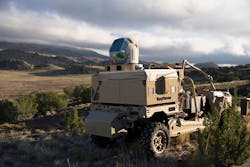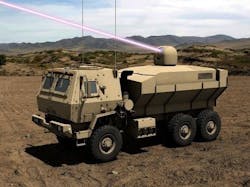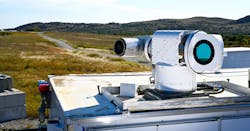Military weapons, such as guided missiles and rockets with warheads, can be large, dangerous, and imposing. They can stop threats at great distances, but these weapons can also inflict unintended damage to the people and objects in proximity to a target, especially when the aiming process is not exact.
In the hopes of targeting with more precision, the U.S. Department of Defense (DoD) and other armed forces around the world have invested in directed-energy weapons (DEWs) for several decades. Among these somewhat elaborate weapons are systems based on high-energy lasers or electromagnetic (EM) waves. Perhaps after so much “dabbling with technology” and too many dead ends for expensive projects, military systems specifiers and designers seek more practical DEW implementations.
While current DEWs are experimental and at best prototype versions of systems, many branches of the military expect to field practical, perhaps even portable, versions of DEW systems within the next two years. Two leading military systems developers, Raytheon Co. and United Technologies, have credited the DoD’s increased interest in DEWs as one of the reasons to merge the two companies into Raytheon Technologies to help meet that two-year plan.
As an example, the U.S. Navy plans to have a laser-based DEW on a warship by 2021. The weapon most likely will be the High Energy Laser with Integrated Optical-dazzler and Surveillance (HELIOS) system. The Navy contracted Lockheed Martin for $150 million (and many possible options) in March 2018 to develop the laser-based DEW system for long-range intelligence, surveillance, and reconnaissance (ISR), as well as a means of bringing down drones or even small boats from a distance. The Navy hopes to make HELIOS part of a guided-missile destroyer in the Pacific Fleet.
Boeing is another early innovator in the area of DEW technology, with more than 40 years of experience in beam control in support of its aircraft. As part of the quest to field DEWs, Boeing’s Compact Laser Weapon System (CLWS) has continued to improve during testing.
In a recent series of five tests conducted with members of the U.S. military, the system was able to track and fully engage over 100 separate flying targets successfully. Such consistent experimental performance points to possible deployment in realistic settings for field evaluation. Boeing has developed both 2- and 5-kW versions of its CLWS for mobile and possible portable use.
Laser Focus
DEWs typically function by focusing an energy beam (generated either by EM energy or laser) on a small spot on a target, causing intense heating of that spot. When the target is a human, the EM heating effect will generally cause the soldier to reverse tracks before collapsing, but it will not cause permanent harm to the target. With a laser-based DEW, an operator can often select the amount of damage from the laser “shot,” even from a considerable distance, such as 500 m.
For example, when targeting an adversary’s jeep, the jeep can be disabled by burning one of the tires or overheating the engine block. For more extensive damage and possible driver/passenger casualties, a DEW operator can target the vehicle’s gas tank. Of course, as important as the quality of a DEW’s energy beam is the precision with which it is focused and the capability to detect and track a target from a distance, even when both the target and the DEW system are moving.
Perhaps the best-known military directed-energy system is the Active Denial System (ADS) developed by the Non-Lethal Weapons Program (JNLWP) of the U.S. Department of Defense. The ADS (Fig. 1) is intended as a non-lethal DEW that sends short bursts of EM energy at a target across distances as far as 1 km and within a target spot size of about 1.5 m. The a military counter-personnel system is transportable and can be used for crowd control in civilian settings. Funding for the program behind the DEW began in 1997 and for the system itself in 2002; efforts are now underway to move the system from a largely “experimental” status to a field evaluation process.
Ideally, the ADS can also be made scalable, so that directed mmWave energy can be placed in the hands of soldiers for in-field use. The impact of those high-power, 95-GHz EM waves will be a heating effect on the surface of the skin. The nature of the EM waves, with much shorter wavelengths than those of lower-frequency signals (such as the 2.45-GHz frequency of microwave ovens, which causes deeper, more dangerous heating), ensures only heating of skin surfaces.
The JNLWP is working with the U.S. Army's Research Development and Engineering Command (RDECOM) Armament, Research, Development and Engineering Center (ARDEC) on the modernization of the ADS. They’re applying the principles of smaller size, weight, and power (SWaP) to shrink two prototype systems for more effective and efficient in-field use. System-level performance goals for the modernized ADS include a shorter range of about 100 m but with a smaller target spot size of about 0.5 m.
One of the keys to reaching performance goals with SWaP is the use of solid-state technology, such as gallium-nitride (GaN) power amplifiers rather than vacuum-tube amplifiers to boost the 95-GHz signals produced by a gyrotron oscillator. An on-board, laser-based range finder provides the precision targeting coordinates to accurately place the EM beam.
In hopes of hastening DEWs from the laboratory to the battlefield, the Raytheon Intelligence & Space portion of the company (now Raytheon Technologies) recently showed some of the capabilities of their high-power-microwave (HPM) and high-energy-laser (HEL) DEWs. The respective high-energy beams were directed at one of the more significant threats in need of termination from a distance with a DEW: unmanned aerial vehicles (UAVs) or drones.
The exercises were performed with U.S. Air Force (USAF) personnel at the White Sands Missile Range (WSMR), Ariz., to evaluate the weapons’ effectiveness and reliability in such a use case. Ironically, this exercise was performed several years after the U.S. Army did a similar evaluation at the same test facility.
“Drones are a real modern threat. Countering them will need a variety of solutions,” said Annabel Flores, vice president (VP) of Electronic Warfare Systems at Raytheon Intelligence & Space. Dr. Thomas Bussing, VP of Raytheon Advanced Missile Systems, added, “After decades of research and investment, we believe these advanced directed-energy applications will soon be ready for the battlefield.”
As part of the exercises, drones served as targets either individually or in swarms. Airmen tasked with defeating the drones were given both HEL and HPM DEWs and only one day’s training with the weapons systems. The laser-based DEW employs a computer-game-type controller, while the microwave-based weapon uses a joystick to steer the beam.
The HEL weapon system (Fig. 2) combines with Raytheon Technologies' Multi-spectral Targeting System of sensors to detect and track the motion of target drones. The sensor and system were mounted on an all-terrain militarized vehicle for mobility. Similarly, the HPM DEW works with sensors capable of providing the targeting information.
These exercises demonstrated that both types of DEW systems are feasible and almost ready for the field. Both systems use different energy sources and can provide different results. The HMP sends out a high-energy microwave beam to disrupt the guidance systems in a drone and can cause even a swarm of drones to fail, whereas HEL-based systems are designed to bring down drones one vehicle at a time. Both DEWs performed flawlessly during the exercises, even when handled by fledgling operators. The exercise was part of the Air Force Directed Energy Experimentation campaign.
Seeing the Light
Solid-state HEL weapons are achieving much higher output-power levels in much smaller package sizes than chemically-based laser weapons. A 100-kW output level is now seen as a minimum for solid-state HEL systems. For example, Dynetics and partners received a $130 million contract to build and test a 100-kW solid-state HEL demonstrator weapon (Fig. 3) for the U.S. Army Space and Missile Defense Command/Army Forces Strategic Command's (USASMDC/ARSTRAT). Partners include Lockheed Martin (which will provide the laser weapons subsystem), MZA Associates, and Rolls Royce LibertyWorks. Dynetics will function as prime contractor, performing final system assembly and test.
Ideally, both HEL and HPM weapons systems will be able to take advantage of solid-state energy sources for smaller, lighter, and even portable DEW systems. Lockheed Martin, for instance, has invested in its Advanced Test High ENergy Asset (ATHENA) HEL weapons system as an effective defense against enemy drones for the USAF.
The laser-based weapon system (Fig. 4) was demonstrated late last year at a test range at Fort Sill, Okla. In that demo, the system shot down multiple fixed-wing and rotary-wing UAVs, teaming with a government command-and-control (C2) and radar sensor to detect, track, and disable each drone using a laser beam. The ATHENA system was successfully operated by USAF personnel with little training, pointing out the potential effectiveness of HEL systems as maritime defensive weapons in the future.
This is a small sampling of the work being done by major contractors on HPMs and HELs in support of DEW systems. The move to solid-state technology is a SWaP step in the right direction since these systems depend on several subassemblies, often including secondary lasers in HELs to “illuminate” a target for more precise targeting with the high-power beam. The two-year estimate may be somewhat optimistic for fielding practical DEWs for any branches of the armed forces. However, it’s driving a way of thinking that such weapons systems are no longer part of science-fiction stories, and may become part of saving lives in military conflicts.




